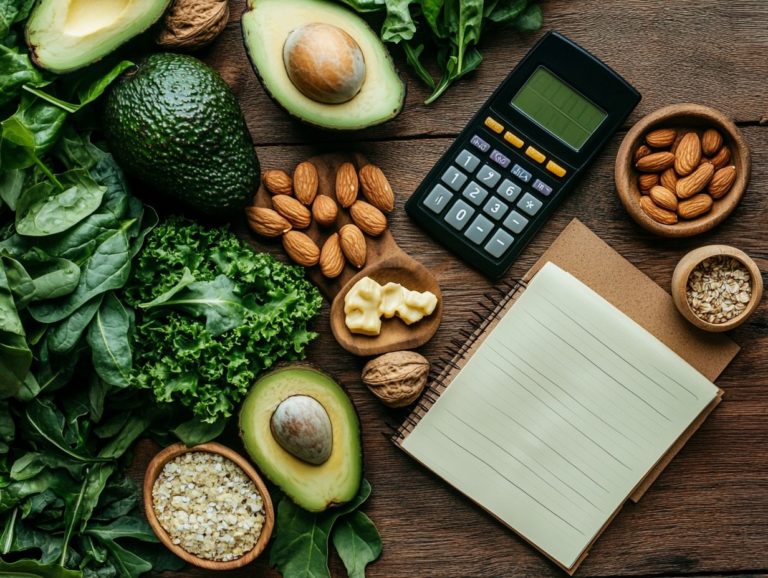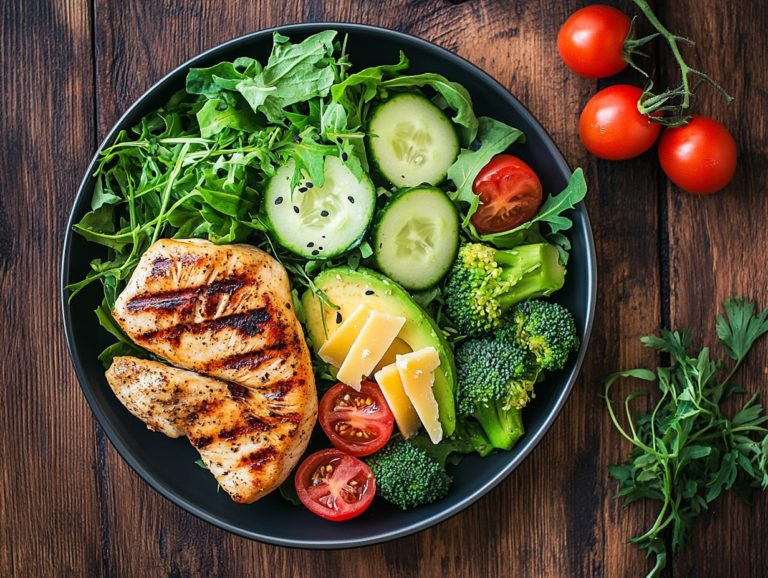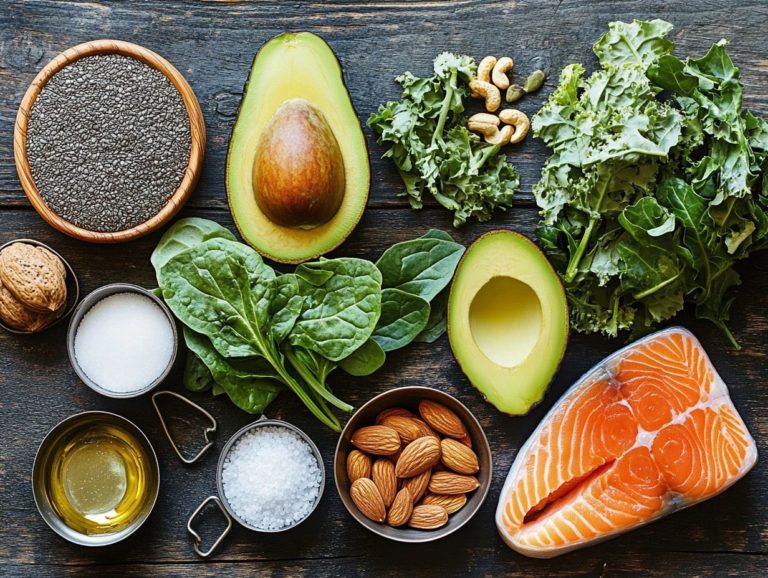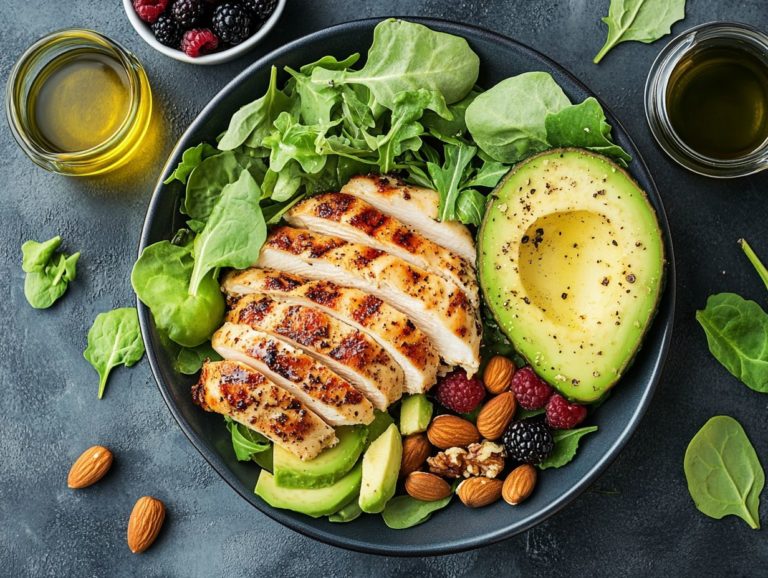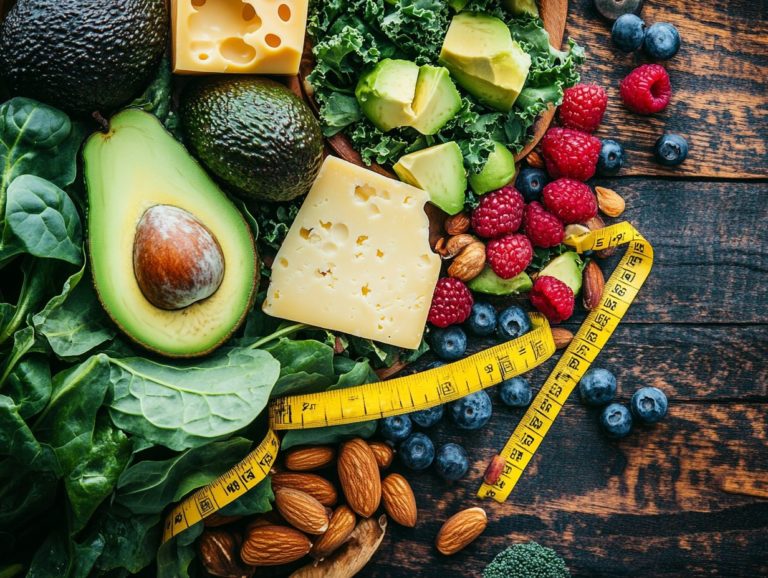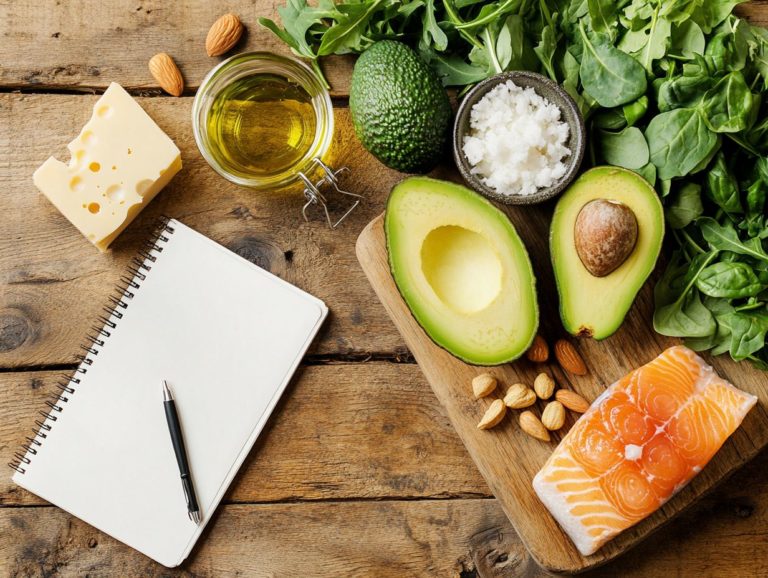How to Create a Nutritional Keto Shopping List
Embarking on a ketogenic diet can be a transformative journey, and it all begins with the right grocery list and shopping essentials.
Understanding which foods to stock up on and which to avoid is crucial for achieving your health goals. This guide will delineate essential categories, from healthy fats and quality proteins to low-carb vegetables and keto-friendly fruits. We will also highlight some pantry staples and fresh herbs to enhance your meal planning.
You’ll discover shopping tips for planning your grocery trips and enticing keto recipes that will keep your meals anything but mundane. Get ready to simplify your keto journey and enjoy every delicious bite!
Contents
- Key Takeaways:
- What Foods Should Be Included in a Keto Shopping List?
- 3. Low-Carb Vegetables
- 4. Nuts and Seeds
- 5. Dairy Products
- What Foods Should Be Avoided on a Keto Diet?
- How to Plan and Prepare for a Keto Shopping Trip?
- What Are Some Keto-friendly Recipes to Try?
- 1. Avocado and Egg Breakfast Bowl
- 2. Grilled Chicken and Vegetable Skewers
- 3. Cauliflower Crust Pizza
- How to Stay on Track with a Keto Diet?
- Frequently Asked Questions
- How do I create a nutritional keto shopping list?
- What should I include on my nutritional keto shopping list?
- How do I stay within my budget when creating a nutritional keto shopping list?
- Can I enjoy my favorite foods on a nutritional keto shopping list?
- How often should I update my nutritional keto shopping list?
- Can I follow a nutritional keto diet without creating a shopping list?
Key Takeaways:
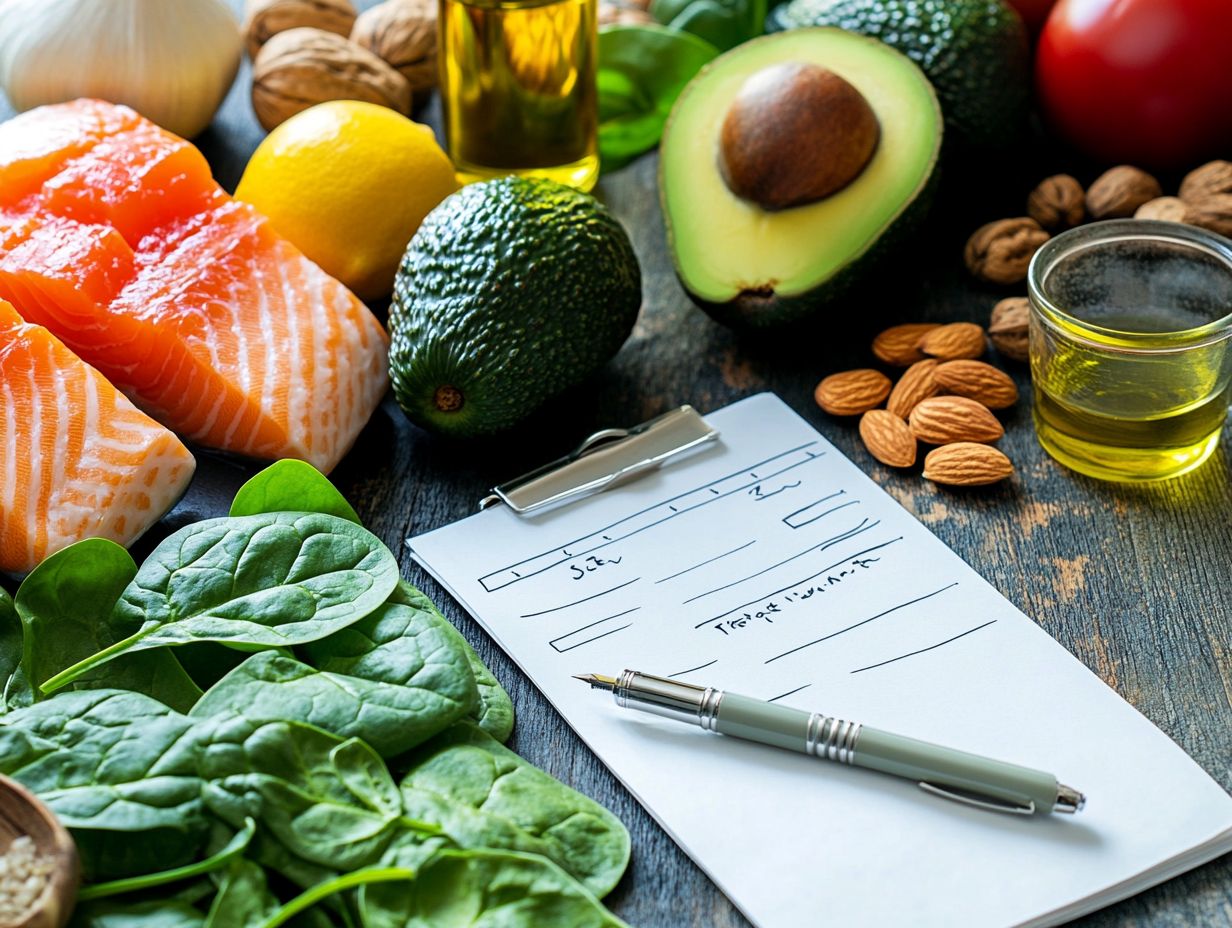
- Stock up on delicious healthy fats, high-quality proteins, low-carb vegetables, nuts and seeds, dairy products, and keto-friendly fruits to fuel your keto adventure.
- Avoid high-carb fruits and vegetables, grains, starchy foods, processed foods, sugary treats, and alcohol on a keto diet.
- Plan and prepare for a keto shopping trip by making a list, reading labels, shopping in the perimeter of the grocery store, and buying in bulk.
What Foods Should Be Included in a Keto Shopping List?
A meticulously crafted grocery list is crucial for anyone embarking on the ketogenic diet. It ensures that you gather the right ingredients to support your weight loss goals while maintaining a balanced intake of healthy fats, proteins, and low-carb foods.
When curating this grocery list, focus on nutritious meals that adhere to keto principles, emphasizing items that are abundant in healthy fats while keeping net carbs to a minimum.
1. Healthy Fats
Healthy fats serve as a cornerstone of your keto diet, providing the essential energy needed for effective fat-burning. They ensure that your meal prep remains both flavorful and satisfying. By incorporating a variety of healthy fats like olive oil, coconut oil, avocado oil, and dark chocolate into your meals, you can significantly enhance the nutritional value and improve your overall health.
These fats not only promote a sense of fullness but also support heart health, boost insulin sensitivity, and aid in the absorption of fat-soluble vitamins. Take olive oil, for example; it’s rich in monounsaturated fats and can be elegantly drizzled over salads or used as a base for dressings.
Coconut oil, packed with medium-chain triglycerides a type of fat that provides quick energy makes a fantastic addition to smoothies or can be used for cooking thanks to its high smoke point. Avocado, brimming with nutrients, can elevate your toast or be blended into creamy dips. Don t forget to add some dark chocolate for a delightful treat that aligns with keto principles.
It’s essential to select unsweetened, high-quality oils and fats, such as cooking oils, to truly maximize the benefits on your ketogenic journey.
2. High-Quality Proteins
Incorporating high-quality proteins into your keto grocery list is essential for maintaining muscle mass and supporting your dietary plan. They provide the vital nutrients that aid in weight loss while keeping you feeling full and satisfied. Think of options like chicken thighs, beef mince, eggs, and seafood not only are they delicious, but they re incredibly versatile for meal planning.
These protein sources are the backbone of satisfying meals that align perfectly with keto principles. For example, seafood like salmon doesn’t just deliver healthy fats; it’s also packed with omega-3s, which can give your heart health a nice boost.
And then there s crispy bacon, which adds a delightful crunch to salads or breakfast dishes. Regarding preparing meals, consider simple yet tasty keto recipes like cheesy egg muffins loaded with spinach or a hearty beef stir-fry that showcases a rainbow of colorful vegetables.
The variety and adaptability of these proteins not only elevate your diet but also make it easier to whip up exciting low-carb dishes that keep you inspired on your keto journey.
With the right ingredients in your cart, you’re one step closer to a vibrant keto lifestyle!
3. Low-Carb Vegetables
Low-carb vegetables are essential to your keto diet, offering vital vitamins and minerals without affecting your daily carb allowance. Incorporate fresh vegetables for better flavor and nutrition. Options like leafy greens, broccoli, and cauliflower can elevate both the taste and health benefits of your dishes while staying true to keto principles. Using seasonal produce and fresh herbs enhances the variety and taste of your meals.
These vegetables are loaded with nutrients that bolster your overall health. Picture tossing leafy greens, such as spinach, kale, and Swiss chard, into a vibrant salad or saut ing them as a delectable side dish. Broccoli and cauliflower are equally versatile. They serve as excellent substitutes in various recipes think cauliflower rice or broccoli gratin making them ideal for anyone seeking nutritious meal options.
Preparing these culinary gems is a breeze. Whether you choose to steam, roast, or blend them into soups, their rich flavors and health benefits will shine through in your low-carb lifestyle.
Start incorporating these vegetables into your meals today for a healthier lifestyle!
4. Nuts and Seeds
Nuts and seeds are delightful treats brimming with healthy fats, making them the perfect low-carb snack choice for your keto diet. By adding a variety of nuts like almonds and coconut to your grocery list, you can enjoy essential nutrients while satisfying your snack cravings without piling on excess carbs. These are fantastic low-carb snacks that you ll love!
Among these options, almonds shine with their remarkable nutritional profile. Packed with vitamin E, magnesium, and fiber, they help you maintain steady energy levels while promoting heart health. Enjoy a handful of almonds as a mid-afternoon snack or blend creamy almond butter into your smoothies to elevate your ketogenic meal game. Sprinkle chopped almonds over salads or add them to homemade keto-friendly granola for that satisfying crunch. Don t forget to include unsweetened options like sugar-free chocolate to keep your snacks healthy.
Don t overlook other seeds, like chia and flaxseed, which can be easily added to puddings or sprinkled atop yogurt. This shows that healthy fats and low-carb choices can be both enjoyable and beneficial as you navigate your keto lifestyle.
Try incorporating these nuts and seeds into your snacks today for a delicious boost!
5. Dairy Products
Dairy products are crucial to your keto diet, delivering a wealth of healthy fats and proteins that enhance meal variety and flavor. With choices like cheese, Greek yogurt, and heavy cream, you can keep your meals creamy and satisfying while adhering to your low-carb dietary plan. Choose full-fat dairy options to maximize the fat macros that support ketosis.
Incorporating these nutritious items into your keto grocery list helps maintain energy levels and supports muscle health. Cheese is wonderfully versatile, perfect for snacking or enhancing dishes, adding both texture and taste. Greek yogurt is a delightful option for breakfast or dessert, packed with probiotics that benefit gut health. Heavy cream is your go-to for creating rich sauces or luscious whipped toppings that elevate any meal. Including cheese options in your diet can significantly enhance your meal prep.
Thoughtfully selecting these dairy products allows you to enjoy delicious meals while staying true to your low-carb goals on your keto journey.
Start adding these dairy options to your meals for a tasty and fulfilling keto experience!
6. Keto-friendly Fruits
Discover the vibrant world of keto-friendly fruits! While fruits are often known for their higher sugar content, you ll be pleased to discover that there are plenty of keto-friendly options you can enjoy in moderation. These fruits provide essential nutrients without derailing your low-carb goals. Consider incorporating low-carb fruits like blackberries and raspberries into your meals. They not only add a delightful burst of flavor and color but also make excellent choices for desserts or snacks.
These berries aren t just a treat for your taste buds; they re also brimming with antioxidants, vitamins, and fiber, making them a superb addition to your ketogenic lifestyle. For instance, tossing a handful of fresh blackberries into a spinach salad can significantly enhance its nutritional profile. Meanwhile, a handful of raspberries can elevate a low-carb yogurt parfait to new heights.
You can often find these seasonal delights at your local farmers’ markets, guaranteeing freshness and flavor. They re perfect for snacking, blending into smoothies, or even crafting keto-friendly sauces. Using fresh herbs with these fruits can further enhance their flavor.
What Foods Should Be Avoided on a Keto Diet?
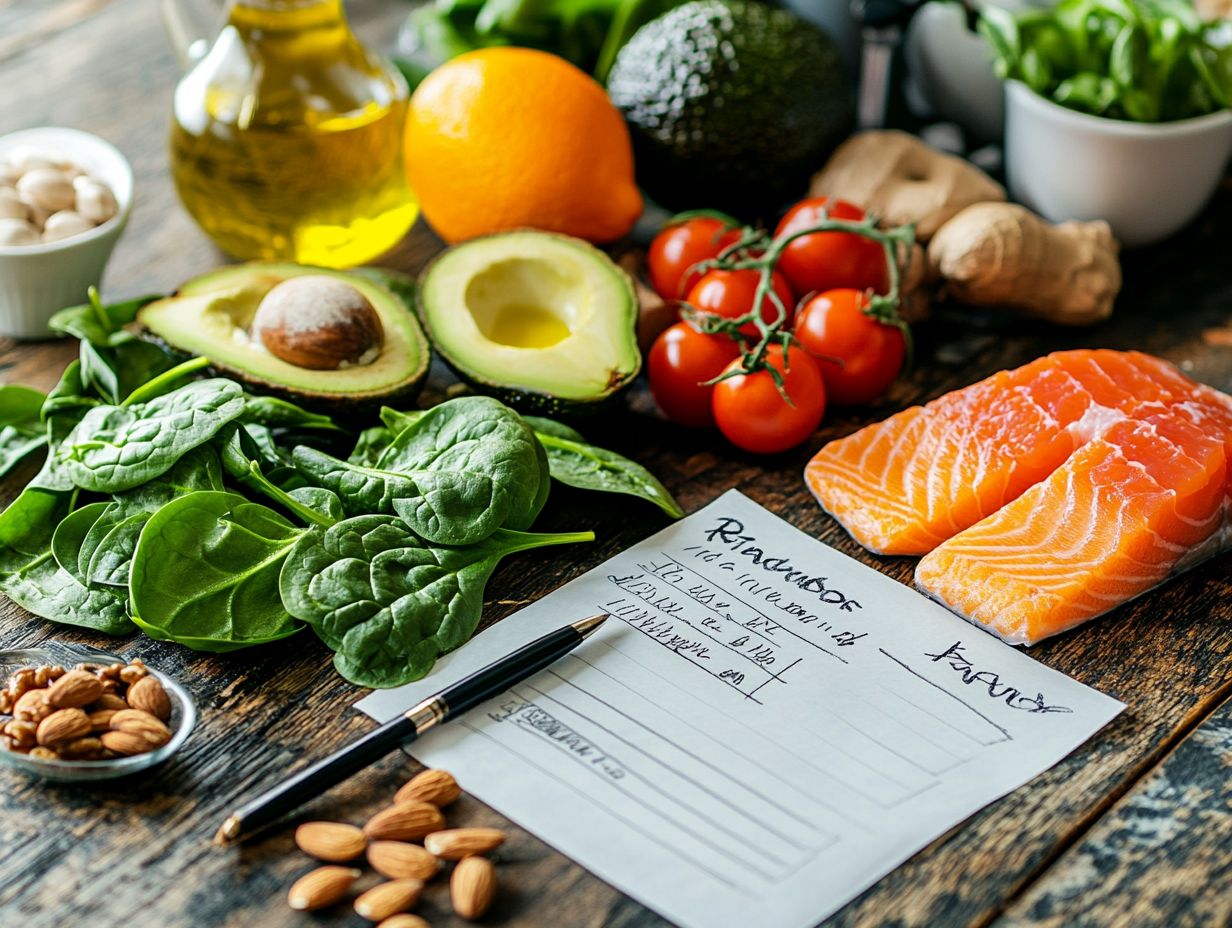
Avoiding certain foods is essential to ensure the effectiveness of your keto diet. Certain items can trigger a spike in net carbs, which could derail your weight loss journey. Pay attention to your shopping tips to avoid these pitfalls.
It s wise to avoid high-carb fruits, grains, foods high in starch, processed snacks, sugary treats, and alcohol. Keeping these items off your grocery shopping list will help you stay aligned with the core principles of the ketogenic diet.
1. High-Carb Fruits and Starchy Vegetables
High-carb fruits and starchy vegetables can significantly impact your carb intake, so it’s wise to steer clear of them on a ketogenic diet; they can hinder your progress toward achieving ketosis. Foods like bananas, grapes, and potatoes should consciously be excluded from your grocery shopping list. Instead, focus on low-carb foods to achieve your weight loss goals.
These items are notorious for their high sugar content and can quickly add up in the carbohydrate count, making it a challenge to stay within the recommended daily limit for a ketogenic lifestyle. For instance, just one medium banana packs about 27 grams of carbohydrates, and a cup of grapes can have a similar carbohydrate load. Starchy vegetables like corn and carrots are also loaded with carbohydrates, which aren’t exactly helpful for maintaining ketosis.
To thrive on a keto diet, it’s crucial for you to focus on low-carb alternatives such as leafy greens, avocados, and select berries. These options provide essential nutrients without compromising your ketogenic goals.
2. Grains and Starchy Foods
Grains and starchy foods like bread and pasta are high in carbs. They can significantly undermine your efforts on the keto diet. It s crucial to eliminate them from your meal planning and grocery list.
Not only do these foods increase your carb intake, but they also make it harder to lose weight. When embracing a low-carb lifestyle, it s important to identify the grains you need to avoid, such as rice, quinoa, and corn.
These grains greatly contribute to your daily carbohydrate limit. Consuming these starchy options can impede your body s transition into ketosis, the state in which your body burns fat for fuel instead of sugar.
By steering clear of such foods and opting for low-carb alternatives like cauliflower, zucchini noodles, and almond flour, you can align more closely with keto principles. This strategic substitution not only helps you maintain appropriate carb levels but also enhances the overall success of your diet.
These alternatives allow you to enjoy satisfying meals without compromising your health goals.
3. Processed and Sugary Foods
Processed and sugary foods often hide sneaky sugars and unhealthy additives that can derail your success on the keto diet. When you re grocery shopping, grab healthier, low-carb snacks that keep you on track!
These sugary offenders not only disrupt your state of ketosis but can also trigger cravings and energy crashes, undermining your overall progress. Many processed snacks are packed with syrups, refined flours, and artificial ingredients that may contribute to inflammation and unwanted weight gain.
Embrace whole foods like avocados, nuts, and cheese for satisfying and nutritious options that perfectly align with keto principles. Rather than grabbing a candy bar, why not indulge in dark chocolate with a high cocoa content or whip up some homemade fat bombs? These delicious choices will satisfy your cravings without derailing your goals!
4. Alcohol
Alcohol can present challenges for you if you’re following a keto diet, primarily due to its carbohydrate content and its potential effects on achieving and maintaining ketosis. It s wise to consider limiting or even avoiding alcoholic beverages altogether. Many popular drinks are sneaky traps, hiding sugars that can derail your weight loss ambitions.
Beverages like beer, sweet wines, and cocktails loaded with mixers can elevate your carbohydrate intake significantly, pushing you right out of ketosis. These drinks introduce not only excess sugar but also obstruct your body s ability to burn fat effectively. When you consume alcohol, your body often prioritizes its metabolization over fat burning, which can stall your weight loss efforts altogether.
During social occasions, you might want to lean towards spirits such as vodka or gin mixed with soda water or opt for dry wines as healthier alternatives. Remaining mindful of portion sizes and scrutinizing ingredient labels is essential for keeping your keto objectives firmly in sight. You ll find it easier to stick to your goals!
How to Plan and Prepare for a Keto Shopping Trip?
Planning and preparing for your keto shopping trip requires a strategic approach to grocery shopping that ensures you obtain only the items that align with your dietary needs. Start by crafting a detailed grocery list centered on low-carb options, including items like healthy fats and protein sources that are essential for your ketogenic diet.
Pay close attention to labels to uncover any hidden sugars, and consider shopping in bulk to make the process more efficient. This preparation will not only streamline your shopping experience but also elevate your keto meal planning to new heights.
1. Make a List
Creating a comprehensive list stands as one of the most essential steps in preparing for your keto grocery shopping trip. It ensures you gather all the necessary ingredients for your meals while steering clear of impulse buys for those tempting high-carb products. Focus your list on shopping essentials that effectively support your keto diet, including meal planning and meal prep for the week.
By dedicating time to craft this list, you can plan your meals in advance, guaranteeing that you have the right fats, proteins, and low-carb vegetables at your fingertips for the week ahead. Organizing your items by category think fresh produce, meats, and dairy can streamline your shopping experience, saving you precious time in the store.
A well-structured list also minimizes the chances of snagging unwanted snacks that could sidetrack your keto commitment, ultimately fostering a healthier lifestyle. With this approach, not only do you make more informed choices, but you also nurture a disciplined mindset when it comes to adhering to the keto diet.
2. Read Labels
Reading labels on food products is crucial for you as someone following the keto diet. It enables you to spot hidden sugars and ensures that the items you choose align perfectly with your low-carb lifestyle. This practice is your shield against processed foods that could sabotage your weight loss efforts. Look for low-carb snacks and net carbs information to better manage your intake.
When you closely examine the nutrition facts, pay special attention to the sugar content and carbohydrate counts listed on the label. Even a seemingly harmless item might harbor added sugars or high-carb ingredients that can swiftly derail your keto goals.
Opting for products with low net carbs and minimal sugar not only bolsters your ketogenic lifestyle but also enhances your overall health. This helps promote weight loss and stable energy levels.
By adopting this diligent routine, you empower yourself to make informed decisions, fully embrace your dietary choices, and cultivate sustained confidence and success on your keto journey.
3. Shop in the Perimeter of the Store
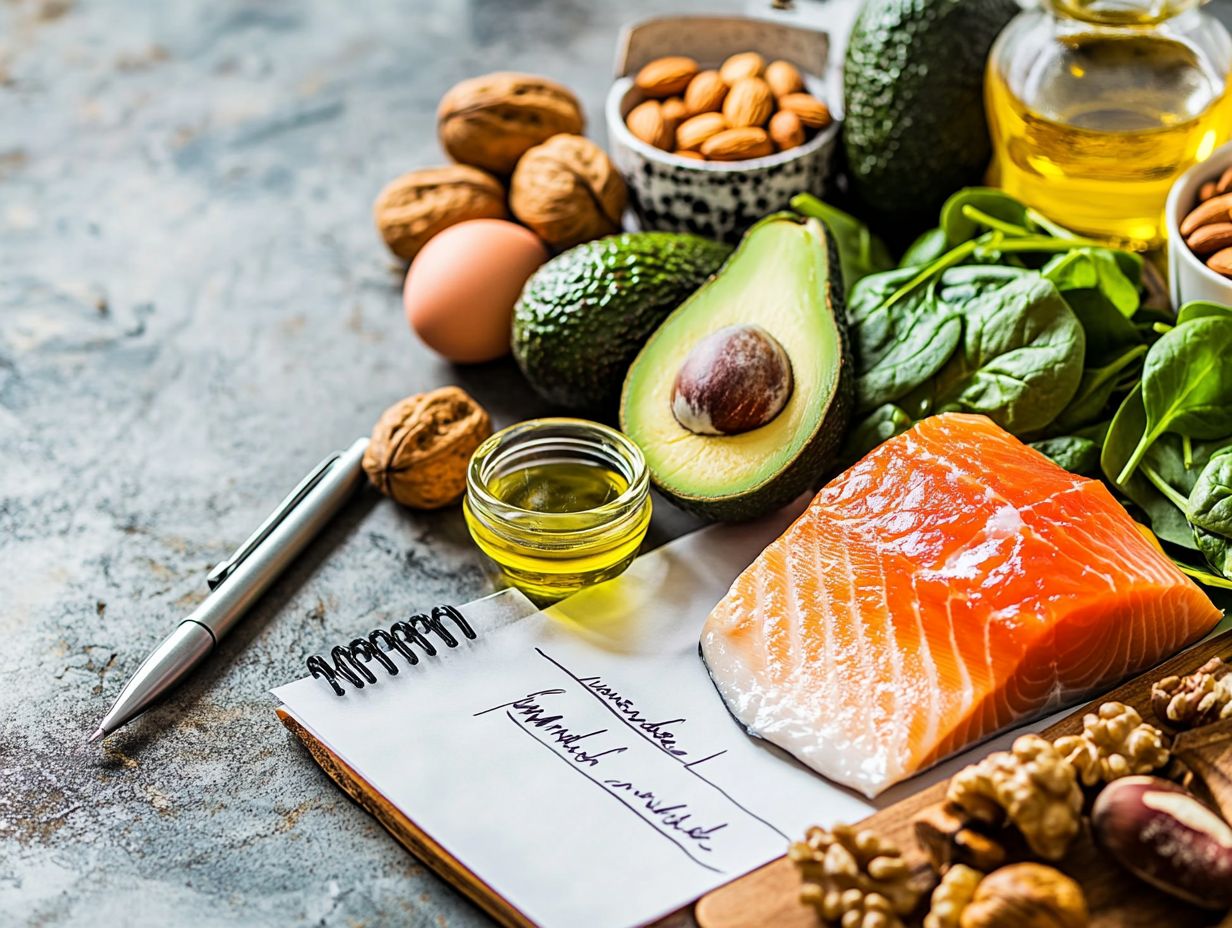
Shopping around the perimeter of the grocery store is a smart choice for anyone adhering to the keto diet. This area is typically home to fresh produce, meats, and dairy products that are essential for your meal planning. By concentrating on whole foods, you can easily sidestep those processed items loaded with unwanted carbs. Don t forget to stock up on grocery store essentials like leafy greens, fresh herbs, and seasonal produce.
This approach not only streamlines your shopping experience but also boosts your chances of sticking to a meal plan that supports your low-carb objectives. You ll often find seasonal fruits and vegetables here that are low in sugar, alongside unprocessed meats bursting with vital nutrients. The dairy products in these sections usually have higher fat content, making them perfect for maintaining ketosis.
Focusing on fresh ingredients fosters creativity in your meal preparation, enabling you to whip up satisfying dishes while steering clear of the processed snacks and sugary temptations that lurk in the center aisles.
4. Buy in Bulk
Buying in bulk can be a savvy strategy for anyone following the keto diet, allowing you to save money while ensuring that you always have essential ingredients on hand for meal prep and planning. Staples like almond flour, nuts, and healthy fats can be purchased in larger quantities, cutting down on those frequent trips to the grocery store. Items like olive oil, coconut oil, and avocado oil are also great to buy in bulk.
Buying in bulk helps you take advantage of discounts typically associated with bulk purchases, leading to significant savings over time. By keeping essentials such as coconut oil, grass-fed butter, and chia seeds readily available, you can adhere to your dietary commitments without the constant worry of running out of key supplies. It s a perfect way to ensure that every meal aligns with keto guidelines while promoting a stress-free cooking experience.
Purchasing items like cheese, frozen vegetables, and spices in bulk will lead to a well-stocked pantry, making your meal planning more efficient and diverse.
What Are Some Keto-friendly Recipes to Try?
Unlock the power of your keto journey with these simple tips! Exploring keto-friendly recipes is a pivotal aspect of fully embracing the ketogenic diet, offering you an array of delectable options that align seamlessly with your nutritional goals, all while ensuring your meals remain vibrant and varied. Consider trying recipes with healthy fats and protein sources like chicken thighs, beef mince, seafood, and bacon.
Picture starting your day with an avocado and egg breakfast bowl or savoring grilled chicken and vegetable skewers for dinner; these recipes leverage healthy fats and low-carb ingredients to craft nutritious meals that bolster your weight loss journey.
1. Avocado and Egg Breakfast Bowl
Start your morning with this nutrient-dense bowl, combining avocado, eggs, and fresh spinach for a balanced meal.
The Avocado and Egg Breakfast Bowl is a simple and healthy meal that embodies the principles of the ketogenic diet. This diet is low in carbohydrates and high in fats, offering a delightful blend of healthy fats and protein to energize your day.
This easy recipe can be whipped up in mere minutes, making it the perfect choice for your busy mornings.
To craft this delightful bowl, begin by gathering ripe avocados, fresh eggs, and your preferred seasonings. Avocados are loaded with monounsaturated fats, which not only fuel your body but also promote heart health and enhance nutrient absorption. Feel free to spice it up with delightful additions like cheese options and nuts and seeds for an extra boost.
Cook the eggs to your liking whether you prefer them scrambled or poached ensuring a creamy texture that beautifully complements the avocado’s richness. A sprinkle of salt, pepper, and perhaps a hint of paprika can elevate the flavors while keeping the meal low in carbs.
This combination guarantees that your breakfast is not only delicious but also brimming with essential nutrients, helping you feel full and energized throughout the morning. Plus, you can easily incorporate ingredients like dark chocolate or coconut oil to keep it exciting.
2. Grilled Chicken and Vegetable Skewers
Grilled Chicken and Vegetable Skewers present a delightful and versatile option for your meal prep on the ketogenic diet. They allow you to savor a medley of flavors while keeping your carb counts impressively low. You can easily customize these skewers with a variety of fresh vegetables, making them ideal for sunny outdoor grilling or hectic weeknight dinners.
Imagine tender chicken breast marinated in rich olive oil, aromatic herbs, and spices these skewers deliver a healthy dose of protein that your body will thank you for. By adding vibrant vegetables like bell peppers, zucchini, and cherry tomatoes, you not only elevate the flavor profile but also boost your intake of essential nutrients and healthy fats.
Preparing the skewers in advance is a game-changer for those busy days when time is of the essence. Grilling them takes mere minutes while ensuring they retain their juicy texture and mouthwatering flavor. Simply place the assembled skewers on the grill for 10-15 minutes, turning them occasionally. Don t miss out on this easy meal that fits perfectly into your busy week!
3. Cauliflower Crust Pizza
Cauliflower Crust Pizza is an exceptional low-carb alternative to traditional pizza. It offers a delightful option for those on the keto diet who wish to indulge without surpassing their carb limits. This recipe not only highlights the versatility of cauliflower but also incorporates healthy fats and cheese, resulting in a meal that is both delicious and satisfying.
To create this savory dish, begin by preheating your oven to 400 F (200 C) and gathering your essential ingredients, including almond flour and full-fat dairy:
- One medium head of cauliflower
- Shredded mozzarella cheese
- Cream cheese
- Eggs
- Seasonings such as garlic powder and Italian herbs
Start by cutting the cauliflower into florets and steaming them until tender. Allow them to cool. Next, pulse the florets in a food processor until they achieve a rice-like texture. Mix this cauliflower rice with the other ingredients like cheese and eggs to form a cohesive dough.
Spread the mixture onto a parchment-lined baking sheet and bake for approximately 25 minutes, or until golden brown. This technique not only yields a crispy crust without the extra carbs but also preserves the wonderful flavors, making it a perfect choice for anyone seeking a guilt-free pizza experience.
4. Zucchini Noodles with Pesto and Shrimp
Zucchini Noodles with Pesto and Shrimp offers you a refreshing, low-carb dining experience that perfectly embodies the spirit of the ketogenic diet. This dish is delightfully colorful and bursting with flavor, making it ideal for a light lunch or dinner. You can savor the exquisite blend of healthy fats from the pesto and protein-packed shrimp. These ingredients create a balanced diet when you meal prep.
The key ingredients in this meal include spiralized zucchini, which is simply zucchini cut into thin noodle-like shapes, fresh basil for that aromatic pesto, garlic, olive oil, pine nuts, and succulent shrimp.
To whip up this delicious dish, begin by saut ing minced garlic in olive oil until it releases its enticing aroma. Then, introduce the shrimp and cook until they turn a lovely pink. In the meantime, blend fresh basil, pine nuts, and olive oil to create a vibrant pesto that s sure to impress.
Once the shrimp are ready, toss in the zucchini noodles, cooking them just until they re tender. Mix in the pesto and shrimp for an enticing finish. This meal not only aligns beautifully with low-carb lifestyles but also offers versatility for your meal planning, effortlessly complementing salads or grilled meats in your weekly menu. Try this vibrant dish tonight for a keto-friendly meal!
How to Stay on Track with a Keto Diet?
Staying on track with the keto diet demands a solid commitment and thoughtful planning, especially when faced with temptations and social gatherings that can easily derail your progress.
By implementing effective meal prep strategies, seeking support within the community, and consistently tracking your progress, you’ll supercharge your keto journey! Embrace these practices, and you’ll navigate the keto journey with greater ease and confidence.
1. Meal Prep
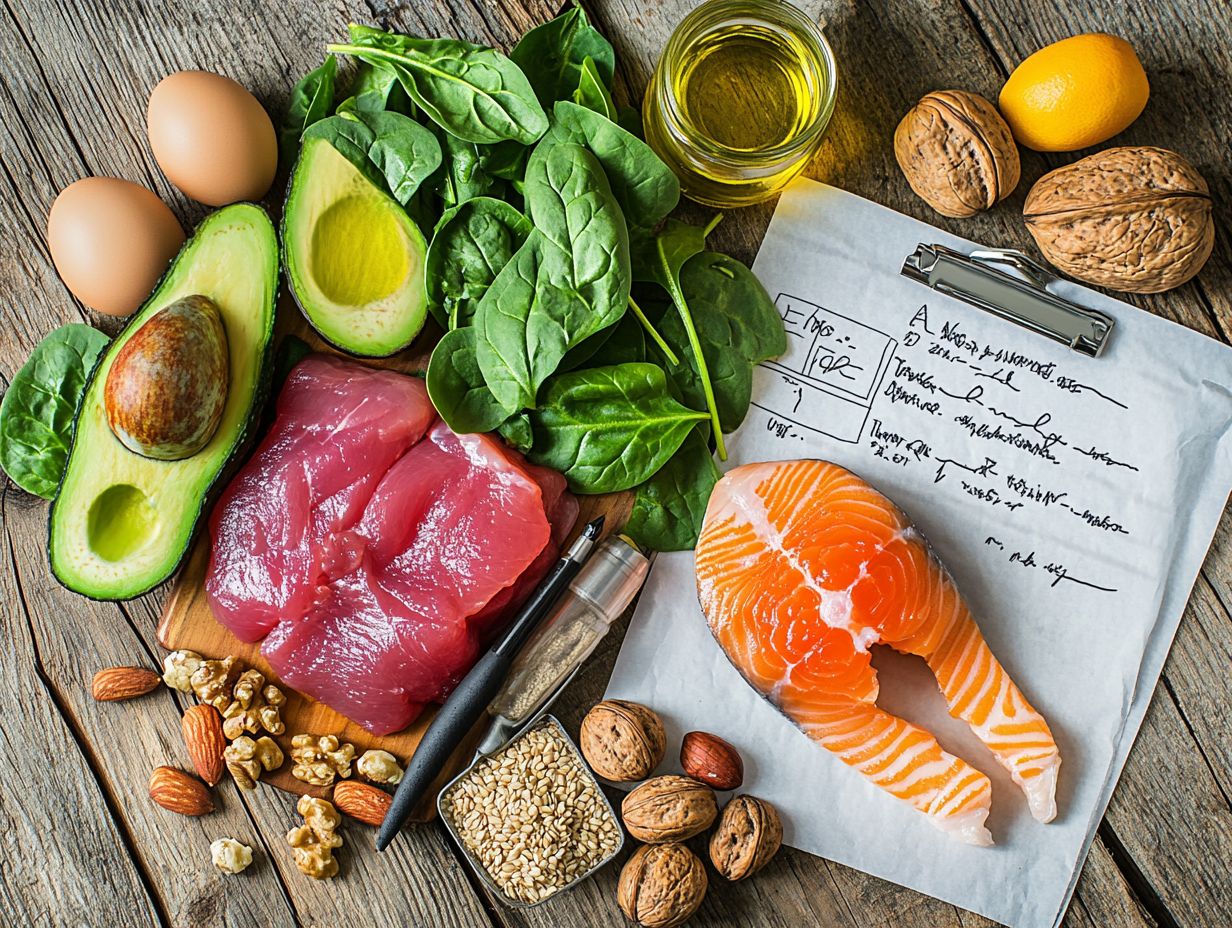
Meal prep is an essential part of your keto journey, allowing you to plan and prepare healthy meals in advance. This proactive approach reduces the temptation to reach for high-carb foods when time is tight. By dedicating just a few hours each week to meal preparation, you can curate a selection of nutritious options that perfectly align with your dietary goals.
This strategy also helps you stick to your low-carb guidelines and saves you precious time during those hectic weekdays. Begin by choosing a handful of key recipes each week that feature healthy fats and proteins think avocado egg muffins or zoodle stir-fries.
Batch-cooking ingredients like grilled chicken or roasted vegetables can streamline your process, making meal assembly a snap.
Investing in high-quality storage containers will elevate your organization game, keeping everything fresh and easily accessible. Plus, creating a grocery list focused on low-carb staples will simplify your grocery trips. This makes the meal prep process for your ketogenic diet both efficient and enjoyable. Include items such as olive oil, coconut oil, heavy cream, and leafy greens to ensure a balanced and nutritious meal.
2. Find Support
Finding support is absolutely essential for achieving success on the ketogenic diet. Surrounding yourself with a community of like-minded individuals offers encouragement, motivation, and valuable resources to help keep you on track. By joining online forums or local groups dedicated to the keto lifestyle, you cultivate a sense of accountability and foster meaningful connections. Sharing keto recipes and tips for grocery shopping can make the journey easier and more enjoyable.
When you engage with others who share similar goals and challenges, navigating the ups and downs of dietary adjustments becomes significantly easier. Participating in social media groups facilitates daily interactions where you can exchange meal ideas, celebrate success stories, and share struggles, which serves to inspire you to keep moving forward.
Local meetups provide an excellent opportunity to form friendships and receive face-to-face encouragement, enriching your journey toward healthier living. These communities celebrate wins together and offer practical advice tailored to real-life situations, reinforcing the idea that the path to ketosis is a journey best traveled with others by your side.
3. Track Your Progress
Methods to Monitor Your Keto Journey
Tracking your progress is essential for maintaining motivation and accountability on the keto diet. It allows you to visualize your weight loss journey and celebrate your successes along the way. By regularly monitoring your food intake and body measurements, you can spot trends and make informed adjustments to your dietary plan.
One effective approach to keeping tabs on your progress is to maintain a detailed food diary. This way, you can gain greater awareness of your carb intake and caloric consumption. Using mobile apps designed for keto tracking makes it easier. With features like barcode scanning for quick food logging and progress graphs that visually depict your weight changes over time, you ll have all the tools at your fingertips.
Monitoring your fat macros and net carbs helps ensure you stay on track. Taking regular measurements not just of your weight but also your waist and hip circumference can provide a more comprehensive picture of your fat loss and muscle gain. Embracing these tracking techniques can significantly enhance your ability to reach and sustain your weight loss goals while fully embracing the keto lifestyle. Start tracking your progress today for the best results on your keto journey!
Frequently Asked Questions
How do I create a nutritional keto shopping list?
To create a nutritional keto shopping list, first determine your daily macros (short for macronutrients, which include proteins, fats, and carbohydrates) and food preferences. Next, research keto-friendly foods and make a list of items that fit into your macros and preferences. Lastly, make sure to include a variety of protein, healthy fats, and low-carb vegetables on your list. Consider adding fresh herbs, seasonal produce, and low-carb snacks like nuts and seeds to keep your meals exciting.
What should I include on my nutritional keto shopping list?
Your nutritional keto shopping list should include a mixture of healthy fats, protein sources, and low-carb vegetables. Some essential items are olive oil, avocado oil, coconut oil, heavy cream, and cheese. For proteins, consider chicken thighs, beef mince, pork, seafood, and eggs. Don’t forget low-carb fruits like blackberries and raspberries, and always include plenty of leafy greens.
Some essential items to include are high-quality protein sources like grass-fed meat and poultry, healthy fats like avocado and coconut oil, low-carb vegetables like leafy greens and cruciferous vegetables, and keto-friendly snacks like nuts and seeds.
How do I stay within my budget when creating a nutritional keto shopping list?
To stay within your budget when creating a nutritional keto shopping list, consider buying in bulk, purchasing items on sale, and opting for frozen or canned options when possible. You can also prioritize buying high-quality protein sources and healthy fats, and supplement with less expensive options like eggs and canned fish.
Can I enjoy my favorite foods on a nutritional keto shopping list?
Yes, you can still enjoy your favorite foods on a nutritional keto shopping list by finding keto-friendly substitutes or making modifications. For example, you can make cauliflower crust pizza instead of traditional pizza, or use zucchini noodles instead of pasta.
How often should I update my nutritional keto shopping list?
Keep your meals fresh! Update your keto shopping list weekly or bi-weekly based on your preferences. This allows you to adjust your list based on your food preferences and any new keto-friendly products that may have become available.
Can I follow a nutritional keto diet without creating a shopping list?
While it’s possible to follow a nutritional keto diet without a shopping list, it may be more challenging to stick to your macros and food preferences. Creating a shopping list can also save you time and money by ensuring you have all the necessary ingredients on hand for your meals.

